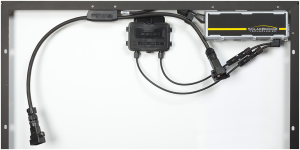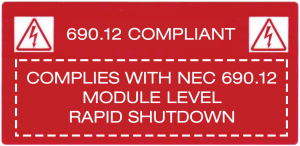I want to address a growing topic of concern among solar photovoltaic (PV) roof installers and the solar PV industry that has slowly crept to the forefront of conversations regarding the electrical safety regulations currently in place. I’m talking about Rapid Shutdown (NEC 690.12)– never heard of it? Oh boy, read on grasshopper…

Image Source: powerstudies.com
Although the vast majority of PV systems are very well designed and modern PV equipment is rigorously tested, shortcuts or small errors can occur during installation. Some folks may not be aware that under normal circumstances modern electrical equipment can absorb some installation “variance,” which can often lead to dangers presenting themselves in the system that are not obvious to installers or system owners during the initial installation. But if a couple of these installation shortcuts get combined with a few unique and unfortunately-timed circumstances, the outcome – in some rare cases – could be disastrous!
Sometimes, the installation can be perfectly up to spec, but unusual environmental circumstances push the design beyond its intended capabilities or expose PV equipment to stresses they were not designed for. If disaster strikes, it is up to the good men and woman of our first responder teams (police, fire, and EMS) to contain the problem and get things back under control. Thanks for your service folks!
In response to this, The National Fire Protection Agency (NFPA) requested that clear guidance and new PV system equipment requirements be added to the National Electrical Code (NEC) which allow PV systems to easily and quickly de-energize before a fire fighter climbs on to a burning building. Just to give an example of how this plays out in a real-world situation, firefighters often ventilate a burning structure by cutting a hole in the roof or walls to reduce the chance that smoke gets too thick inside. Now, if there is a PV solar system installed on the roof and the sun is shining, high voltage DC conductors will remain live and energized. Even though the firefighters have shut down power to the building, a first respondent could cut right into these live conductors which are often found routed directly under the roof surface or behind exterior walls. We are all aware that fire fighters wear insulated clothing that offers protection, but coming into contact with 400 volts DC is a “surprise” they are not prepared to risk. Fire fighters have made it clear to the PV industry they want those conductors shut down!

TrueAC modules comply with 690.12 –
there is no power outside the array other
than the AC input to the inverter
The 2014 National Electrical Code has a new section under Article 690 called Rapid Shutdown (690.12). This section of the Code demands that PV systems “shall include a rapid shutdown function that controls specific conductors in accordance with 690.12 (1) through (5)”. The Code then explains where these conductors are and how the shutdown is carried out. Although the NFPA Code Making Panel that pushed for Rapid Shutdown wanted the PV array shut down to the module level (i.e. to the back of each PV module), it was agreed that the 2014 NEC language would address DC wires away from the array and/or under the roof line and that module level shutdown would be considered by the Code Making Panels in the next Code cycle (2017).
The 2014 edition of the NEC® has incorporated changes to address fire fighter safety concerns …one of the key features is new section 690.12 on rapid shutdown…
- Requirements for controlled conductors shall apply only to PV system conductors of more than 1.5 m (5 ft) in length inside a building, or more than 3 m (10 ft) from a PV array.
- Controlled conductors shall be limited to not more than 30 volts and 240 volt-amperes within 10 seconds of rapid shutdown initiation.
- Voltage and power shall be measured between any two conductors and between any conductor and ground.
- The rapid shutdown initiation methods shall be labeled in accordance with 690.56(B).
- Equipment that performs the rapid shutdown shall be listed and identified.
(NEC, 2014)
There is good news! AC module systems comply with the Rapid Shutdown requirements in the 2014 Code. Not only that, they comply with any new Code language demanding the PV system be shut down to the module level –“module” being a major key player in this equation.

Rapid Shutdown (NEC 690.12) compliant
label for PV systems
What welcome news for fire fighters that arrive on a site where an AC module system has been installed – they have options! Remove the meter (cutting utility power), or throw PV system disconnects or the main breaker in the service entrance panel. Either will result in the entire system being shut down all the way back to each AC module. Fire fighters can rest assured that the system is completely de-energized and they can go about their job as if on any normal building.
Looking forward, installers need to label AC module systems with signage that indicates that this PV system complies with Rapid Shutdown (NEC 690.12). They should display this signage prominently, right at the service entrance and they should certainly inform the new system owner that they have the safest and most fire fighter-friendly solar system available today!
– Terence Parker
Manager, Applications Engineer – SolarBridge Technologies
National Electrical Code (NEC) 2017 brought some big changes to the world of PV design and permitting.
To read more about this see Changes to Article 690 in NEC 2017